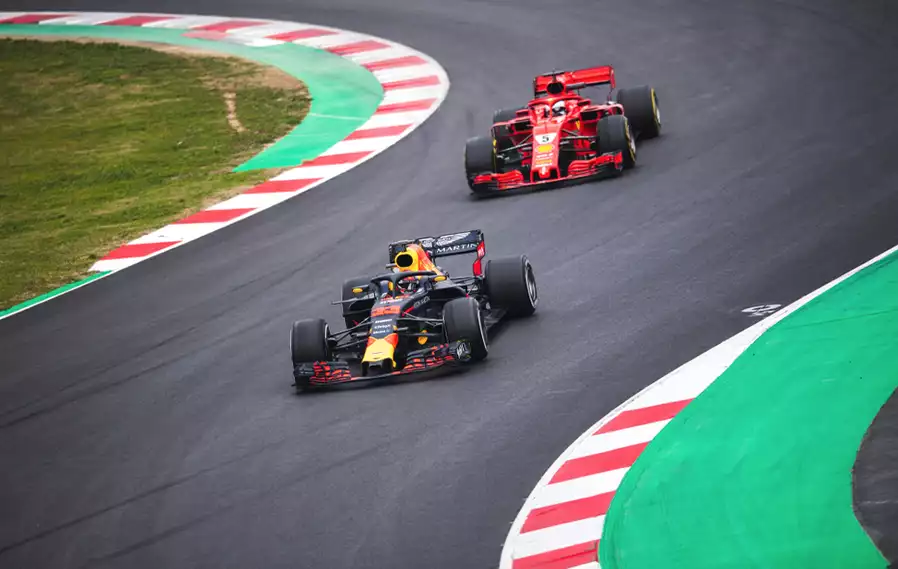HANS, or Head and Neck Support, is a safety device used in Formula 1 racing to protect drivers from head and neck injuries during accidents.
The device consists of a tether that attaches to the driver’s helmet and a series of straps that attach to the driver’s suit. During a crash, it helps reduce the amount of force applied to the driver’s head and neck. Removing some of the force will reduce the risk of serious injury. The use of HANS has become mandatory in Formula 1 racing, demonstrating the importance placed on driver safety in this high-speed and dangerous sport.
Table of Contents
Watch this video to see Rosberg explain HANS.
Key Takeaways
- HANS (Head and Neck Support) is a safety device worn by drivers in motorsports to protect their neck and head in the event of a crash.
- It works by limiting the amount of forward motion of the driver’s head and by absorbing and distributing the energy of a crash.
- HANS was developed as a response to the increasing number of head and neck injuries in motorsports.
- The mandatory use of HANS in Formula 1 racing highlights the importance placed on driver safety in the sport.
- The FIA sets the regulations and standards for HANS in Formula 1 racing and tests and certifies all HANS devices used in the sport.
- HANS has played a critical role in improving the safety of Formula 1 racing. It has helped to save lives and prevent serious injury in the sport.
- The continuous improvement of HANS technology will likely lead to further improvements in the safety of motorsports in the future.
The Development of HANS
Early Racing Safety Measures
In the early days of motorsport, drivers had limited protection and safety measures in place. Basic safety equipment, such as helmets and fire-resistant suits, were introduced to reduce the risk of injury. However, they did not address the risk of head and neck injuries. As the sport evolved and speeds increased, the need for more advanced safety measures became evident.
Evolution of Head and Neck Supports
Over time, head and neck supports were developed and improved to address the risk of injury during accidents. Early designs consisted of simple neck braces, but these proved to be insufficient in protecting drivers during high-speed accidents. In the 1980s, engineers and researchers began developing advanced head and neck support systems, including the HANS device, which became widely adopted in motorsport. Today, HANS is recognized as a vital component of driver safety in Formula 1 racing.
Introduction of HANS in F1 Racing
The FIA, the governing body of Formula 1 racing, made the use of HANS mandatory in 2003. This move emphasized the importance placed on driver safety in F1 racing and highlighted the effectiveness of HANS in reducing the risk of injury. Today, HANS is an integral part of a Formula 1 driver’s safety equipment. It is widely credited with saving lives and preventing serious injury in the sport.
Importance of HANS in F1 Racing
The introduction of HANS in Formula 1 racing marked a major step forward in driver safety. The high speeds and intense competition of F1 racing make it one of the most dangerous sports in the world. However, head and neck injuries are a common occurrence during accidents in the sport of F1. The use of HANS helps mitigate this risk by reducing the amount of force applied to the driver’s head and neck during a crash.

How HANS Works
Explanation of HANS Technology
The head and neck support system consists of a tether that attaches to the driver’s helmet and a series of straps that attach to the driver’s suit. The tether is designed to limit the amount of forward motion of the driver’s head during a crash. Following it will reducing the risk of neck and head injuries. The straps are designed to absorb and distribute the energy of a crash, reducing the amount of force applied to the driver’s head and neck.
Advantages of HANS in Protecting Racers
The use of HANS provides several advantages in protecting Formula 1 racers. By limiting the amount of forward motion of the driver’s head during a crash, HANS reduces the risk of neck and head injuries, which can be serious or even fatal. Additionally, the straps of the HANS device are designed to absorb and distribute the energy of a crash, reducing the amount of force applied to the driver’s head and neck. This helps prevent serious injury and reduces the risk of death in the event of a crash.
Types of HANS Devices Available
There are several types of HANS devices available for Formula 1 racers. Each with unique features and benefits. Some popular types include the Pro Ultra, the Sport II, and the SLX. These devices vary in their design, weight, and materials, and racers can choose the one that best suits their needs and preferences. The choice of HANS device is a personal one. It is important for racers to select the device that provides the best protection and comfort for their individual needs.
Regulations and Standards for HANS in F1 Racing
FIA Requirements
The FIA, the governing body of Formula 1 racing, sets strict requirements for the use of HANS in the sport. These requirements are designed to ensure that HANS devices provide the highest level of protection for drivers in the event of a crash. The FIA specifies the minimum standards for HANS devices, including the size, weight, and performance of the devices.
Mandatory Use of HANS in F1 Racing
The use of HANS in Formula 1 racing is mandatory. All drivers must use a HANS device that meets the FIA requirements. This requirement applies to all races, practice sessions, and testing sessions. The mandatory use of HANS in Formula 1 racing highlights the importance placed on driver safety in the sport.
Testing and Certification Process
All devices used in Formula 1 racing must be tested and certified by the FIA. This testing process ensures that the devices meet the minimum standards set by the FIA. It also assures their HANS device will provide the necessary protection in the event of a crash. The testing and certification process is rigorous, and only devices that meet the FIA requirements are approved for use in Formula 1 racing.
Frequently asked questions about HANS
What is HANS and why is it used in F1 Racing?
How does HANS work to protect racers?
What types of HANS devices are available for F1 racers?
Conclusion
HANS (Head and Neck Support) is an important aspect of Formula 1 racing. Its purpose is to reduce the risk of neck and head injuries in the event of a crash. It works by limiting the amount of forward motion of the driver’s head and by absorbing and distributing the energy of a crash. The mandatory use of HANS in Formula 1 racing highlights the importance placed on driver safety in the sport. The FIA sets the regulations and standards for HANS in Formula 1 racing and tests and certifies all HANS devices used in the sport.



